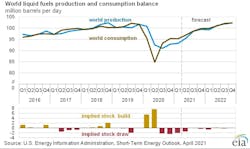EIA forecasts tighter-than-expected second quarter
In its April Short-Term Energy Outlook, the US Energy Information Administration (EIA) forecasts a tighter oil market in second-quarter 2021, due to lower-than-expected production from the Organization of the Petroleum Exporting Countries (OPEC).
Monthly average Brent crude oil prices in March were the highest since late 2019. Crude oil prices in early March reached $70/bbl following OPEC+’s Mar. 4 announcement that it was extending production limits through April. However, prices subsequently declined, which partly reflected slowing global oil demand growth as COVID-19 cases increased, notably in Europe.
On Apr. 1, OPEC+ said it would ease existing limits on production beginning in May. The news was generally consistent with EIA’s assumption in last month’s STEO. However, Saudi Arabia also announced it would gradually relax its voluntary 1.0 million b/d cut over the May–July period. This means that, if implemented as announced, Saudi Arabia’s increase would occur more slowly than EIA had previously assumed. In its March STEO, EIA expected Saudi Arabia ending voluntary cuts of 1.0 million b/d, along with the relaxation of cuts that were extended through April at the Mar. 4 OPEC+ meeting.
So, EIA revised its forecast for second-quarter 2021 OPEC crude oil production down by 500,000 b/d from the March STEO. With lower production from OPEC than in the March STEO, EIA expects markets will be somewhat tighter in the second quarter than previously forecast, contributing to some upward price pressures.
“We forecast that the Brent crude oil price will average $65/bbl in the second quarter, when quarterly stock draws average 1.5 million b/d. Although that rate represents a significant draw in stocks, it is down slightly from the first quarter of 2021, when we estimated stock draws averaged 2.1 million b/d,” EIA said.
EIA also forecasts that Brent prices will average $65/bbl in second-quarter 2021, $61/bbl during second-half 2021, and $60/bbl in 2022.
In this report, EIA expects global oil inventories to fall by 1.8 million b/d in first-half 2021, compared to 1.2 million b/d forecasted in its March STEO.
Increases in global oil supply will contribute to a mostly balanced market during second-half 2021, EIA forecasts. However, the forecast depends heavily on future production decisions by OPEC+, the responsiveness of US tight oil production to oil prices, and the pace of oil demand growth, among other factors.
OPEC crude oil production is expected to rise to 25.8 million b/d in second-quarter 2021 from an average of 25.1 million b/d in first-quarter 2021. EIA expects OPEC crude oil production will rise to almost 27.9 million b/d in second-half 2021.
According to EIA’s most recent data, US domestic crude oil production averaged 11.1 million b/d in January 2021. EIA estimates that US domestic crude oil production declined by 800,000 b/d in February, mostly because of cold temperatures that affected much of the country, particularly Texas. US crude oil production is expected to average 10.9 million b/d in second-quarter 2021 and increase to almost 11.4 million b/d by fourth-quarter 2021. US crude oil production is forecast to average 11.9 million b/d in 2022. The forecast of rising US crude oil production is the result of EIA’s expectation that WTI crude oil prices will remain above $55/bbl through the forecast period.
EIA estimated that the world consumed 96.0 million b/d of petroleum and liquid fuels in March, an increase of 4.7 million b/d from March 2020. Global consumption of petroleum and liquid fuels will average 97.7 million b/d for all of 2021, which is up by 5.5 million b/d from 2020. The growth in global liquid fuels consumption in 2021 was revised higher from the last STEO, reflecting higher global GDP growth forecasts from Oxford Economics, which increased 0.4 percentage points from the March STEO to 6.2% for 2021. EIA also forecasts that consumption will increase by 3.7 million b/d in 2022 to average 101.3 million b/d.
